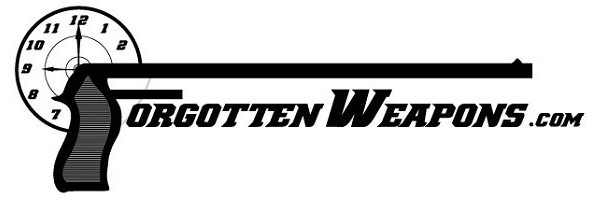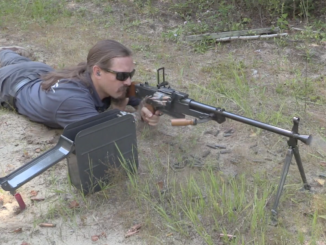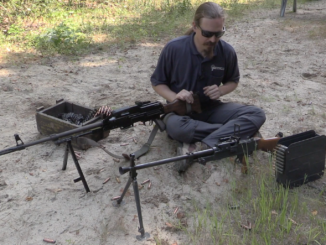When CZ developed the vz.38 pistol for the Czechoslovak military, they made a number of attempts to also sell it on the international export market. This involved offering some various changes in configuration for different clients – in this case, scaling it down from .380ACP to .32 ACP. It also has a manual safety, another feature absent on the domestic military model but included in export variants. This example is the only known one produced in .32 caliber, and it has the serial number 100001.
Many thanks to the VHU – the Czech Military History Institute – for giving me access to this unique prototype to film for you. The Army Museum Žižkov is a part of the Institute, and they have a 3-story museum full of cool exhibits open to the public in Prague.If you have a chance to visit, it’s definitely worth the time! You can find all of their details (including their aviation and armor museums) here:
https://www.vhu.cz/en/english-summary/




“(…)scaling it down from .380ACP to .32 ACP(…)”
According to In 1936, the Czechoslovak military ordered 70,000 additional vz.24 pistols, but they were also seeking a simpler design that could be produced more cheaply and maintained more easily, and it seems likely that Myška was already working on such a design. His patent for the ČZ-38 was granted on 6 November 1936 as Czechoslovakian patent number 65558.(…)
According to R. J. Berger, there is a three-quarter size double/single-action (DA/SA) 7.65mm prototype with a 1936 date and the serial number 100001; this gun may have been used to make the patent drawings. A similar but larger prototype, with a 1937 date and the serial number 300001, is chambered for the 9mm P-08 cartridge; this gun is in the collection of the Military History Institute in Prague. It is larger and heavier than the production ČZ-38, and holds nine cartridges in the magazine. According to the museum exhibit, another 9mm Parabellum prototype was made with a rotary barrel locking system and a double/single action trigger. According to Berger, a number of other early pistols are known, all dated 1937, with either double action only (DAO) or double/single action (DA/SA) mechanisms, and all with wooden grips.
If above holds true, then it was exactly opposite, said design was first executed as 7,65 mm Browning weapon and then made to fit 9×17 mm Kurz cartridge.
I forgot to paste link for above quote, it is https://unblinkingeye.com/Guns/CZ38/cz38.html
In mid-March 1939, the “Rest of the Czech Republic” was occupied by the German Reich – after the Sudetenland was returned to the German Reich following the Munich Agreement and Slovakia declared its independence – and transformed into the “Reich Protectorate of Bohemia and Moravia”. Among other things, the defense department was transferred to the German Reich. It also paid for the more than 16,000 M-38s that had been completed by September 1939. They mainly went to the Reich Labour Service (RAD), the “Organization Todd” (equivalent to today’s THW) and the Reich Air Force. In December 1939, the ‘M-38’ was introduced into the Wehrmacht as the contract or loot weapon ‘P. 39(t)’, where it was soon given the nickname “Nutcracker” due to its droll appearance. (Note: The Czecho-Slovaks had already called her this before. “Louskáček” means ‘nutcracker’ – and the term later found its way into the Wehrmacht via Sudeten Germans and defected Czecho-Slovaks).
However, further production of the ‘P.39(t)’ was discontinued. Both the Army Ordnance Office and the troops did not like the model. The predecessor models CZ ‘M-24’ and ‘M-27’, on the other hand, were very popular.
If, for example, the “nutcracker” was carelessly pulled out of the pistol pouch when “unholstering the pistol”, it could happen that the unlocking slide for disassembly was actuated with the thumb. If the target was hit with a little momentum, the slide could then swing forward and fly off. (Note: This feature was even “specially” practiced by various jokers in the Luftwaffe in order to then stage “lamp shootings” at an advanced hour and with a great deal of alcohol for the purpose of general amusement)…
For its rather weak 9 x 17 mm caliber, this breech-loading pistol was quite heavy with a loaded weight of approx. 1 kg. It was not at all popular in the Wehrmacht and everyone tried to get rid of it as quickly as possible and exchange it for something else.
But: the Finns had always had a weakness for exotic side arms! This was also the case here: at their express request, they received around 1,700 of them by September 1940. Structurally introduced as the ‘9.00 pist/39 tsekk.’, it even proved itself very well in the so-called Continuation War 1941-44. Its design was so simple that it was practically unaffected by the Arctic frost. The Bulgarians were also served with the CZ ‘M-38’: after the structural introduction, they simply converted the odd but inexpensive piece to a normal trigger on their own initiative and also integrated a manual safety. What the Bulgarians and Finns called their “nutcrackers” is not known…
I wonder if the manually decocking Cz75 action has design elements in common with DA/SA version of the Cz38?
I believe that the majority of the action design for the CZ-75 series was taken up from the S&W Model 39/59 family, but I could be mistaken.
I always marvel at the incredible finishing on all these arms from Austria-Hungary and post-empire manufacture: Steyr, Mannlicher, CZ, FEG, right up to WWII. I suppose modern finishes are more durable but this piece in particular is just beautiful.
It comes down to craftsmen, outmoded processes that were incredibly toxic, and time.
Today, these finishes are prohibitively expensive to create due to the environmental concerns, the lack of a widespread base of technical experts with the knowledge to do them, and the fact that the more modern and less esthetic finishes are more accessible and cheaper to apply in a production setting.
It’s like a lot of things… You could do them, but the average person won’t pay for them. Witness the difference between all the people who look at the Colt snake-line pistols, going “oooooh” and “awwww”, promising to buy them, and when Colt makes it happen, the promises dry the hell up. I remember talking to a distributor at a gun show, long time ago, on this very subject: He’d gotten stuck with a whole raft of special-order Smith & Wesson pistols that he’d had them do up, had a list of people who said they’d buy them, and when he got the pistols in hand from S&W, something like 90% of the people who’d signed up reneged on the whole thing. He got stuck with a couple of hundred fancy guns that he wound up selling at cost or below… He was not a happy camper about that, at all.
It’s unfortunate, but sadly true: Most people won’t pay for old-school high quality work. It’s the same in every industry… How many people are willing to pay for really good boots? Clothes in general? Not as many as are willing to settle, clearly.
Everything is made disposable today…